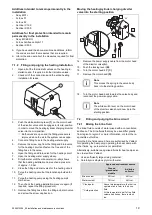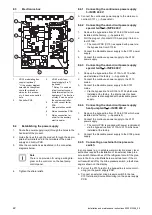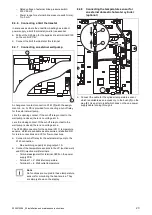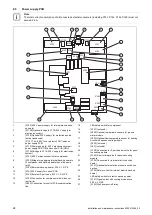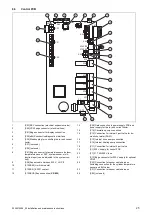
20
Installation and maintenance instructions 0020213394_05
Approved environment source
Ground
/groundwater
module
Air/brine
collector
Cloud point* of the
aqueous ethylene
glycol mixture
-16 °C
-30 °C
Cold protection** of
the aqueous ethyl-
ene glycol mixture
-18 °C
-33.5 °C
* Cloud point
** Cold protection
Above this temperature, the first ice
crystals start to form in the brine
fluid.
At this temperature, half of the fluid
volume has frozen; there is slush
ice.
▶
Check the mixture ratio of the brine fluid.
–
Working materials: Refractometer
In the event of special requirements, the following heat trans-
fer medium is also authorised by Vaillant for the ground heat
source:
–
Aqueous solution with 33%
±
1% vol. propylene glycol
7.2.2
Filling the brine circuit
66
48
62
71
37
A
B
42a
63
61
33
67
65
33
Dirt filter
37
Automatic air separator
42a
Brine expansion relief
valve
48
Manometer (optional)
61
Isolation valve
62
Isolation valve
63
Isolation valve
65
Brine collecting vessel
66
Brine container
67
Filling pump
71
Brine diaphragm expan-
sion vessel
A
From the heat source
to the heat pump (hot
brine)
B
From the heat pump to
the heat source (cold
brine)
1.
Install a dirt filter
(33)
in the pressure line.
2.
Connect the filling pump's pressure line to the isolation
valve
(62)
.
3.
Close the isolation valve
(63)
.
4.
Open the isolation valve
(62)
.
5.
Connect a hose, which leads to the brine fluid, to the
isolation valve
(61)
.
6.
Open the isolation valve
(61)
.
Caution.
Risk of material damage caused by an
incorrect filling direction.
If you fill the brine pump against the direction
of flow, this may lead to a turbine effect which
can damage the pump's electronics.
▶
Ensure that the brine pump is filled in the
direction of flow.
7.
Use the filling pump
(67)
to pour the brine fluid from the
brine container
(66)
into the brine circuit.
7.2.3
Purging the brine circuit
1.
Start up the filling pump
(67)
in order to fill and rinse
the brine circuit.
2.
Decrease the output of the filling pump to reduce the
amount of air entering the brine circuit.
3.
Allow the filling pump
(67)
to run for at least 10 minutes
in order to fill and rinse the circuit sufficiently.
4.
Then close the isolation valves
(61)
and
(62)
and
switch off the filling pump
(67)
.
5.
If required, repeat this rinsing process.
6.
Open the isolation valve
(63)
.
7.2.4
Building up pressure in the brine circuit
1.
Use the filling pump
(67)
to pressurise the brine circuit.
Note
To operate the brine circuit without any
problems, a filling pressure of 0.17 MPa
(1.7 bar) is required. The expansion relief
valve opens at 0.3 MPa (3 bar).
2.
Read off the pressure on a manometer (on-site).
–
Brine fluid operating pressure range: 0.07 to
0.20 MPa (0.70 to 2.00 bar)
3.
Build up the pressure in the brine circuit by opening the
isolation valve
(62)
and using the filling pump to top up
the brine fluid.
4.
If required, reduce the pressure in the brine circuit by
opening the isolation valve
(61)
to drain brine fluid.
5.
Check the brine circuit's filling pressure in the heat
pump's display.
6.
If required, repeat the process.
7.
Remove the two hoses from the valves
(61)
and
(62)
.
8.
Purge the system once more after starting up the heat
pump.
9.
Label the container that holds the remaining brine fluid
with information about the type of brine fluid and the
set concentration.
10.
Pass the vessel with the remaining brine fluid on to the
end user to be stored. Point out to the end user that
there is a risk of injury when handling brine fluid.














